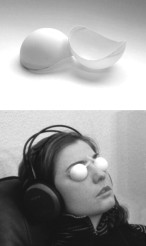Ganzfeld hallucinations
 The cognitive science journal Cortex has just released a special issue on the neuropsychology of paranormal experiences and belief, and contains a fantastic article on hallucinations induced by the Ganzfeld procedure.
The cognitive science journal Cortex has just released a special issue on the neuropsychology of paranormal experiences and belief, and contains a fantastic article on hallucinations induced by the Ganzfeld procedure.The Ganzfeld procedure exposes the participant to ‘unstructured’ sensations usually by placing half ping-pong balls over the eyes so they can only see diffuse white light and by playing white noise through headphones.
It is probably best known for its uses in parapsychology experiments, but it is also used to induce hallucinations and sensory distortions which are much more likely to occur in the absence of clearly defined sensory experiences.
The article reviews the sorts of hallucinations reported in during these experiments and discusses what electrophysiology (EEG or ‘brain wave’) studies tell us about what happens in the cortex when these perceptual distortions kick off.
Some of the descriptions of hallucinations are really quite striking:
“For quite a long time, there was nothing except a green-greyish fog. It was really boring, I thought, ‘ah, what a non-sense experiment!’ Then, for an indefinite period of time, I was ‘off’, like completely absent-minded. Then, all of sudden, I saw a hand holding a piece of chalk and writing on a black-board something like a mathematical formula. The vision was very clear, but it stayed only for few seconds and disappeared again. The image did not fill up the entire visual field, it was just like a ‘window’ into that foggy stuff.”
“An urban scenery, like an empty avenue after a rain, large areas covered with water, and the city sky-line reflected in the water surface like in a mirror.”
“A clearing in a forest [Lichtung], a place bathed in bright sun-shine, and the trunks of trees around. A feeling of a tranquil summer afternoon in a forest, so quiet, so peaceful. And then, suddenly, a young woman passed by on a bicycle, very fast, she crossed the visual field from the right to the left, with her blond long hair waving in the air. The image of the entire scene was very clear, with many details, and yes, the colors were very vivid.”
“I can see his face, still, it’s very expressive… [I could see] only the horse that comes as if out of clouds. A white horse that jumped over me.”
“A friend of mine and I, we were inside a cave. We made a fire. There was a creek flowing under our feet, and we were on a stone. She had fallen into the creek, and she had to wait to have her things dried. Then she said to me: ‘Hey, move on, we should go now’.”“It was like running a bob sleigh on an uneven runway right down… [There] was snow or maybe water running down… I could hear music, there was music coming from the left side below.”
“In the right side of the visual field, a manikin suddenly appeared. He was all in black, had a long narrow head, fairly broad shoulders, very long arms and a relatively small trunk…. He approached me, stretching out his hands, very long, very big, like a bowl, and he stayed so for a while, and then he went back to where he came from, slowly.”
You can simulate the Ganzfeld procedure in your own home by taping two half ping-pong balls over your eyes and listening to the radio tuned to static in an evenly lighted room.
The other articles in the special issue are also fascinating, and range from a study finding greater body asymmetry is related to higher levels of unusual beliefs -- likely reflecting asymmetrical brain development, to an experiment looking at the cognitive psychology of people who believe they’ve been abducted by aliens.
Needless to say, there’s many more fascinating studies and Cortex has the advantage of not only being a leading neuropsychology journal but also making its material freely available as open-access articles.
Enjoy.
Link to Cortex special issue.
No comments:
Post a Comment